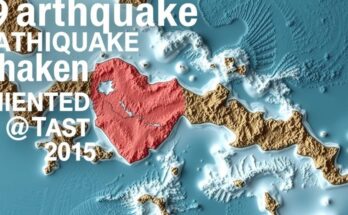The ceasefire between Israel and Hezbollah signals a potential decline in Iran’s regional influence, as it marks a significant setback for the Iranian regime, which has relied on proxy groups to engage in conflict. The operational defeats faced by Hezbollah and the Iranian economy’s struggles point to challenges for Iran as it seeks to maintain its power and credibility. The dynamics of this ceasefire may foreshadow broader changes within Iran and the geopolitical landscape of the Middle East.
The recent ceasefire between Israel and Hezbollah in Lebanon offers a reprieve from the ongoing violence and signifies a substantial setback for Iran, the primary supporter of Hezbollah. This agreement is significant not only for halting the intense bloodshed that has transpired over recent months but also for its potential implications on Iran’s influence in the region. Iran, which has been a key financier and arms supplier to both Hezbollah and Hamas, has long utilized these groups to engage in conflicts with Israel without engaging in direct confrontation themselves.
The escalation of hostilities was initiated by Hezbollah shortly after Hamas launched an assault on Israel on October 7. Iran’s indirect support for such actions, exemplified by the constant arms supply to Hezbollah via Syria, indicates their strategic deployment of proxy warfare. However, the Israeli military’s recent operations, termed “Operation Northern Arrows,” have led to significant damage to Hezbollah’s infrastructure, including the destruction of tunnels and command centers which Iran had aided in building.
Moreover, Israel’s successful targeted strikes against key Hezbollah leaders have compounded this humiliation for Iran, which is already feeling the strain of internal dissent and a struggling economy. This situation compelled Iran to leverage diplomatic channels to stabilize the conflict. Notably, while the ceasefire provides a momentary peace, Hezbollah’s ongoing desire to retaliate against Israel raises doubts about the durability of this agreement.
Tehran’s efforts to project power in the region are faltering, especially if the Lebanese government regains authority over its borders, undermining Iran’s influence. The current geopolitical landscape suggests that Iran’s leadership is at risk, with domestic opposition growing against their funding of foreign militant groups rather than addressing pressing internal issues, such as rampant inflation and unemployment among the youth. With the United States adopting a tougher stance on Iran under the incoming administration, the ramifications of the ceasefire could herald significant changes in the Middle East, potentially jeopardizing the future of the Iranian regime itself.
The conflict between Israel and Hezbollah has existed amid a broader pattern of violence in the Middle East, greatly influenced by Iranian backing of militant groups. The hesitance of Iran to engage directly in armed conflict, instead opting to support proxies, positions it in a complicated strategic scenario. The intricate dynamics between these entities, combined with broader geopolitical factors including U.S. foreign policy, create a framework for understanding the recent ceasefire. The evolving situation surrounding Hezbollah, Hamas, and their patron Iran is instrumental in defining regional stability and security. The internal pressures facing Iran also play a critical role, as public dissatisfaction with the government mounts due to a faltering economy and perceived misprioritization of resources.
In conclusion, the ceasefire in Lebanon not only curtails immediate violence but also poses significant challenges to Iran’s regional ambitions. As Hezbollah faces pressure and setbacks, Iran’s attempts to project itself as a formidable power in the Middle East are increasingly in jeopardy. The dynamics surrounding this ceasefire highlight the essential link between internal and external pressures on the Iranian regime, suggesting that the days of the current leadership may be numbered if these trends continue. Increased calls for accountability from the Iranian populace may shift the strategic balance in the region, potentially marking the beginning of an impactful transformation in Middle Eastern politics.
Original Source: www.telegraph.co.uk




